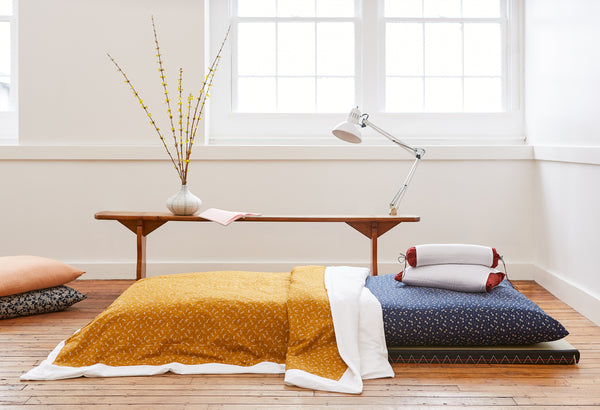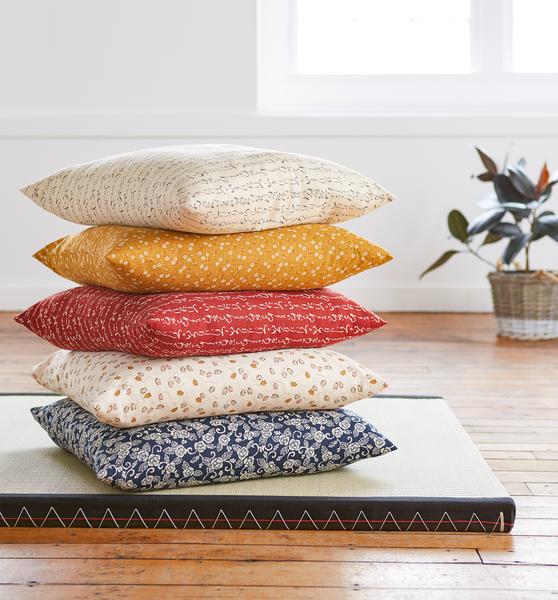When you walk into a Japanese bedroom, there’s a good chance there won’t be a bed in sight. At least not in the western sense of the word. The Japanese have maintained a unique, minimalist approach to sleeping for centuries, a sleep system that’s vastly different from much of the rest of the world.
But while this traditional method for sleeping is most popular in Japan, it’s becoming a more frequent choice for people outside of the country who are in search of a deeper sleep, and perhaps a more minimalist lifestyle to boot.
So how do the Japanese sleep, and how is it different than Western-style beds? We’re breaking it down, below.

The basics:
The biggest differentiator in the traditional way the Japanese sleep is that they sleep on the floor, on top of a precisely arranged combination of cushions and mats.
At the bottom is a tatami mat, followed by a Shikifuton (or mattress) and a kakebuton (the duvet), and topped off with a buckwheat hull pillow. Here's a look at the role each component plays in a good night's sleep.

The Tatami Mat
Tatamis are soft mats made from rice straw fill and a rush grass cover. They were traditionally used as flooring throughout Japanese homes, but today they’re primarily found in a designated tatami room, which is most often used for sleeping. Tatami mats can also be rolled up during the day when not in use, and rolled out at night in smaller spaces where there isn't a dedicated tatami room, or to open a tatami room for other uses.
Tatamis make the floor more comfortable, and also serve as a breathability and moisture barrier between the futon mattress and the floor. Most modern Tatami mats have a built-in moisture resistant layer..

The Shikifuton
The second component in the Japanese sleep system is the shikifuton (or shikibuton). These are thin mattresses (typically three or four inches thick) made from layers of cotton fill tucked inside a cotton cover.
When it’s time to sleep, the shikibuton is rolled out over the tatami, and rolled back up again and stored during the day. This allows the tatami room or sleeping area to be used for other purposes during the day, and also for the shikibutons to air out. The Japanese often hang them in the sun during the day to prevent mold or mildew from forming.
Shop J Life Shikifutons and covers here.

The Kakefuton
A kakefuton (or kakebuton) is a traditional Japanese duvet. It’s typically filled with silk fibers, which help retain and spread heat evenly, and are also hypo-allergenic and inhospitable to dust mites. Kakefuton covers are often paired with the kakefuton for easy maintenance and washing.
J-Life makes custom kakefuton covers which can be purchased in addition to or separately from our kakefutons.
Shop J Life Kakefutons and covers here.

Buckwheat Hull Pillows
The final component of the traditional Japanese sleep system is the buckwheat (sobakawa) hull pillow. These pillows are made from an inner case filled with thoroughly washed (and usually organic) buckwheat hulls and an outer sleeve. The inner case has a hidden zipper that makes it easy to add or remove buckwheat hulls to adjust the firmness and comfort level of the pillow. Buckwheat hulls also allow air to circulate throughout the pillow, keeping the surface cool.
While the buckwheat hulls themselves cannot be washed, they can be removed from the cases and stored while the cases are washed.
Shop J Life Buckwheat Hull Pillows and covers here.

The benefits of a Japanese-Style Bedroom
Proponents of the Japanese sleep system claim many benefits--both health and otherwise--to sleeping on the floor.
Among them:
- Cooler temperatures, since cool air settles to the floor.
- Better circulation, and reduced back and muscle pain.
- Better spinal alignment.
- Eco-friendliness, as shikibutons are made only from cotton.
- More space, since the mattress can simply be rolled away when it’s not in use leaving more living space.
Other Japanese sleep principles:
In addition to the futon sleep system, the Japanese have a number of other common practices when it comes to sleeping. Among them:
- Co-sleeping. Japanese families often share two or three large futons spread over a tatami room, with parents sleeping next to babies and young children.
- Napping, just not in beds. When the Japanese roll up their futons for the day, they aren’t rolled back out until bedtime. But that doesn’t mean the Japanese don’t nap. Inemuri is the name for the Japanese phenomenon of napping wherever, whenever. At work, on the subway, on a park bench. Whenever they need a quick recharge, they take a quick nap wherever they happen to be.


12 comments
I live in Southern California is the a store to look at products near me?
I am 72yrs old with the problems that go with it. I have recently started using the Japanese style of sleeping but by adapting my orthopaedic bed.
I am already noticing an improvement in my sleeping pattern and relief from pain.
I now look forward to going to bed instead of avoiding it. I took my inspiration from a Japanese film!!!
I think the world needs to do this European/American style beds take up way too much space and are so HEAVY.
I love their style of sleep where do they sell the stuff in the USA?
can you wash or dry clean the kakefuton duvet?